
Having a morning back pain strategy has been one of the most helpful aspects to reducing my inflammation and keeping myself in control of my own pain cycle. I wish I could say I owe it all to one person or one great book but it came through research and a lot of trial and error. My situation may be a little different from yours but there are always common themes you can look at in most back pain cases. Today, I want to dive head first into my personal morning back pain strategy. I want to show you exactly what I did to go from having my wife do all my lifting in the morning to being able to bend and twist with little to no pain at all!
I just recently did a video version of this topic with more current info and strategies if you want to sit back and watch click the video below!
What I wanted to do for you this week is give you some practical tips for you to start using immediately to start seeing relief.
One of the number one topics I find myself talking more and more about with back pain sufferers is their morning back pain.
The first step to beating morning back pain is get a super expensive mattress right!?
Wrong.
I want to give you a short checklist of key areas to focus on before going to bed and after you wake up all to give you more control over your back pain throughout the day.

Morning Back Pain Relief Strategy 1: Before Bed
I know this is going to sound counter productive but I want you to stop stretching. I know thats not what your personal trainer says to do but take it from someone who battled chronic back pain for over 6 years (which included brutal morning back pain). What you do BEFORE you go to bed will impact how you feel first thing in the morning.
So after getting out of the shower instead of getting on the floor for 15 minutes to stretch grabe a book and spend some time on your belly reading or maybe go for a brisk walk (if the weather is cool enough to keep you from sweating).
If you want to learn more about my take on stretching check this out!
While in bed:
Tossing and turning is a big factor in the middle of the night. Those of us who already have super sensitive discs whether from a recent procedure, inflammation or DDD, you have to be mindful of how often you move.
The biggest help to me and people who I have worked with is A) find the sleeping position that fits you best: Side or on your back (no belly sleeping). B) Use lots of pillows.
I have a 4 pillow system at night. One for my head, one for my arms, one for my legs and one for my back. The one on my back keeps me snug and from subconsciously rolling over while I sleep. The less you move the better your body has the chance to heal.
If you do have to get up or roll over, BRACE YOUR CORE. This is a habit you will have to get the swing of. Bracing your core provides stability to the spine and allows you to make a move without causing any disruption.
Check out the bracing write up I did here if you need to get some pointers.
First thing in the morning:
If it was up to me I would have everyone go for an 8 minutes fast paced walk every morning. Nothing other than walking. This gently gets the blood flowing and muscles contracting without doing any potental pain inducing moves like sitting, squatting, lunging, bending etc.
A few others I will ad in…
Stop bending over, stop stretching or any kind of flexion-based exercises first thing in the morning. Also, Don’t change your clothes, don’t go sit on the toilet first thing in the morning or plop on the couch and watch the news. Make the first 1-2 hours every morning a no sitting time. This is key to the health of your discs.
The problem is your discs fill with fluid throughout the night so in the morning they are super hydrated and full. Any problems you may have will only be exaggerated first thing in the morning. Allow your body to equalize after getting up and take care of all your “standing things first”. Allow your spine to adapt to standing and moving around.
Before bed check-list:
-Have your clothes picked out and on top of your dresser or hanging up.
-Have your shoes and socks somewhere where you don’t have to bend to pick them up.
-Have your lunch packed and on the counter or top shelf of your fridge
-Briefcase, books, or any bag you take with you, have it already packed and on top of a table or counter.
All of these applied to your daily routine WILL bring relief, you just have to take action.
Start implementing these things today!
Be sure to meet me back here Wednesday! I have another practical tip you can start doing immediately.
William
P.s. If you found any of this valuable please share it with your friends! I would love to get a discussion going and answer their questions!

